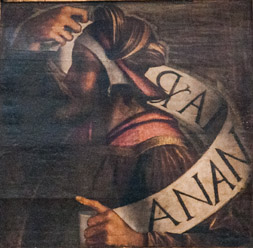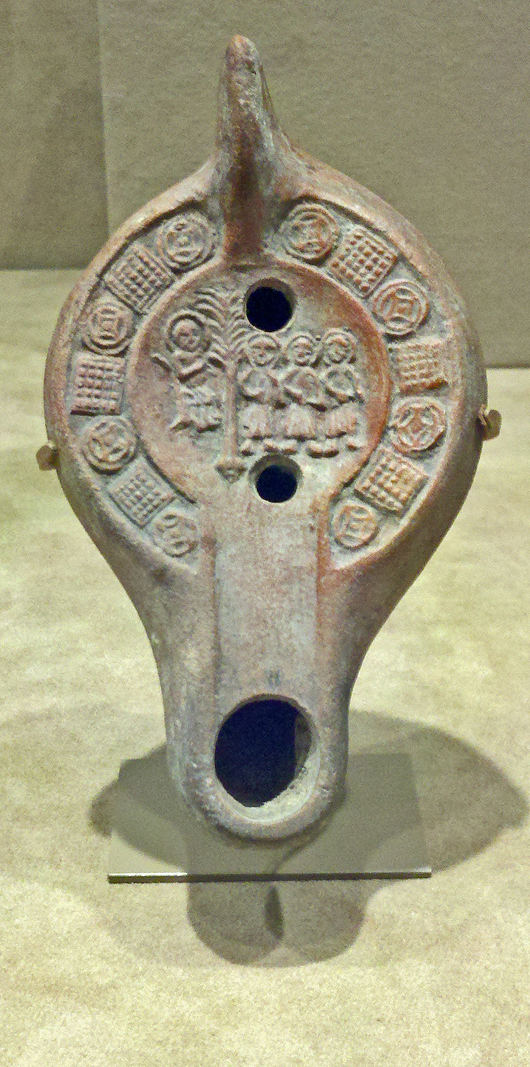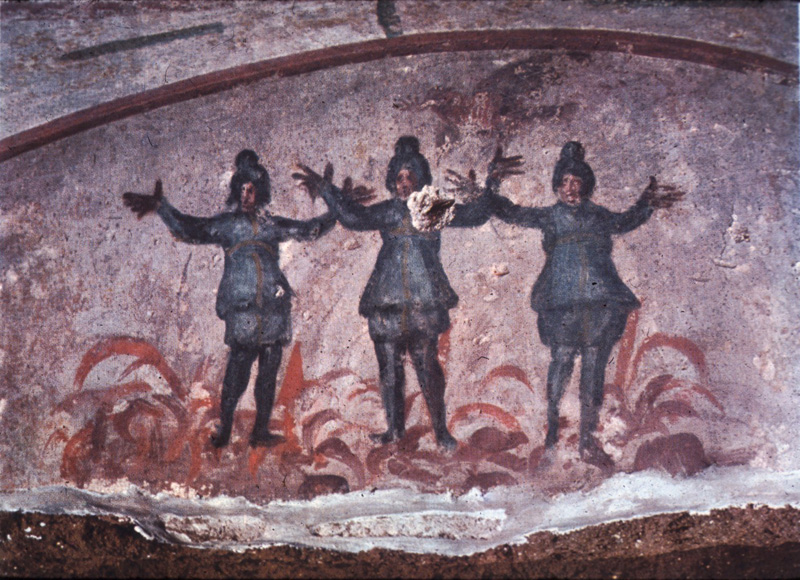In Daniel 3, the faith of these three young men is tested by an order from Nabuchodonosor that all in his kingdom bow down to a gold idol he has had made. When they refuse, they are cast into a furnace so hot that it actually kills the servants who push them in. But an angel comes and blows on the flames to create an island of cool comfort in the midst of the furnace. Highly impressed, the king has the three released from the furnace and orders that their god is to be given respect, "for there is no other god that can save in this manner."
In the Greek and Vulgate texts the story includes two prayers sung by the youths while in the furnace (3:26-45 and 51-90). The second of them, the Cantus trium puerorum or "Canticle of the Three Young Men," has been in use for Christian morning prayers since the earliest centuries and possibly even since Apostolic times.3
The prayers and their use in Christian worship help explain why the earliest images of the three youths show them in the hands-up "orant" posture – that is, at prayer. This is the case in the 3rd-century image shown above.
That image is from the Catacomb of Priscilla, where Christians were buried. In the early centuries of the Christian era the youths' passage from deadly fire to salvation became a way of expressing the hope of resurrection. Thus we find them not only in the catacombs but also on sarcophagi, as in this example from Rome. One sarcophagus in the Vatican Museums even has two images of the youths, a small one on the lid and a large one on the right end. In these and almost all others the youths are shown in the actual fire, although some instead depict their refusal of idolatry, a pressing concern for the early Christians. (example).
Another indication of widespread interest in the Three Youths is their appearance on small oil lamps in various parts of the Mediterranean world (examples).
-
THE CANTICLE OF THE THREE YOUNG MEN
- Bless the Lord, all ye works of the Lord, praise and exalt Him above all forever.
- Bless the Lord all ye heavens; bless the Lord all ye angels of the Lord.
- Bless the Lord all ye waters that are above the heavens; let all powers bless the Lord.
- Bless the Lord, ye sun and moon; stars of heaven, bless the Lord.
- Bless the Lord, every shower and dew. All ye winds, bless the Lord.
- Bless the Lord, ye fire and heat; cold and chill, bless ye the Lord. All ye winds, bless the Lord.
- Bless the Lord, dews and hoar frosts; frost and cold, bless the Lord.
- Bless the Lord, ice and snow; nights and days, bless the Lord.
- Bless the Lord, light and darkness; lightning and clouds, bless the Lord.
- Let the earth bless the Lord; let it praise and exalt Him above all forever.
- Bless the Lord, ye mountains and hills; everything growing from the earth, bless the Lord.
- Bless the Lord, seas and rivers; fountains, bless the Lord.
- Bless the Lord, ye whales and all that move in the waters; all you fowls of the air, bless the Lord.
- Bless the Lord, all ye beasts and cattle; sons of men, bless the Lord.
- Bless the Lord, Israel,; praise and exalt Him above all for ever.
- Bless the Lord, priests of the Lord, servants of the Lord, bless the Lord.
- Bless the Lord, spirits and souls of the just; holy men of humble heart, bless the Lord.
- Bless the Lord, Ananias, Azaria, and Misael; praise and exalt Him above all for ever.
- Let us bless the Father and the Son, with the Holy Spirit; let us praise and exalt Him above all for ever.
- Blessed art Thou, Lord, in the firmament of heaven; and worthy of praise, and glorious above all for ever.
- Amen. Source: Thesaurus Precum Latinarum © copyright by Michael Martin
Return to paragraph 3
Prepared in 2013 by Richard Stracke, Emeritus Professor of English, Augusta University
HOME PAGE
Painting from the Catacombs of Priscilla, 2nd half of the 3rd century. (See the description page.)
OTHER IMAGES

A ceiling panel picturing Shadrach/Hananiah in Santa Maria dei Miracoli, Venice. See the description page.

Small oil lamp with a scene of the three youths before Nebuchadnezzar. See the description page.
MORE IMAGES
- Late 4th century: A sarcophagus panel in Milan depicts the youths refusing to adore the idol.
- 1536: Jacopo Bassano's Shadrach, Mishach, and Abednego in the Fiery Furnace pictures the moment when Nebuchadnezzar frees the youths from the furnace.
NOTES
1 These are their Latin names as used in the Vulgate. In the King James Version the king's name is rendered "Nebuchadnezzar" and the Israelites are "Shadrach," "Meshach," and "Abednego." Daniel 1:6-7 explains that these were the young men's Babylonian names. Their Hebrew names were "Hananiah," "Mishael," and "Azariah" (KJV) or "Ananias," "Misael," and "Azarias" (Vulgate), which is what the youths call themselves while praying in the furnace (Vulgate Daniel 3:88).
2 At the time of their selection the three were most likely children. According to the Jerusalem Bible, "In eastern courts those destined for the career of 'letters'…were trained from childhood" (p. 1422, note b to Daniel 1:4). Christian literature in Latin often refers to them as the tres pueri, the three boys. But in Daniel 3, the chapter on the fiery furnace, they are consistently called "men."
3 See Smith 1449-50 and Freeman 124.
